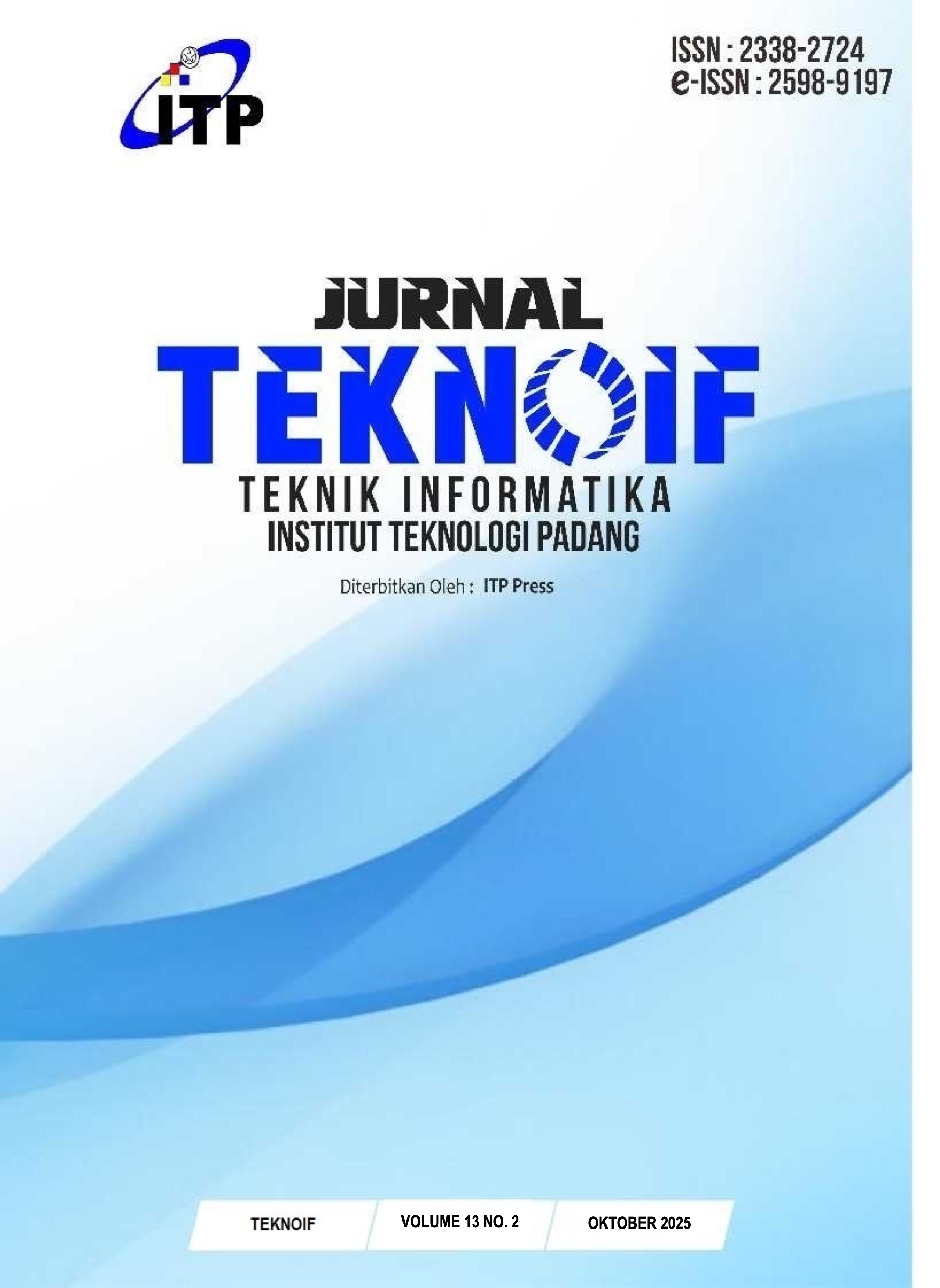IMPLEMENTATION OF FEEDFORWARD NEURAL NETWORK FOR CARDIOVASCULAR DISEASE PREDICTION WITH PERFORMANCE EVALUATION
DOI:
https://doi.org/10.21063/jtif.2025.V13.2.97-104Kata Kunci:
Cardiovascular disease, Feedforward neural network, risk prediction, confidence factor, Machine LearningAbstrak
Disease is crucial to prevent more serious complications. This study implemented a Feedforward Neural Network (FNN) algorithm to build a cardiovascular disease risk prediction model using patient clinical data. The dataset used was sourced from open sources and underwent preprocessing stages such as one-hot encoding and normalization. The model architecture consists of two hidden layers with ReLU and dropout activation functions, and an output layer with a sigmoid function for binary classification. Training was conducted for 100 epochs with a data split ratio of 80:20. Evaluation was carried out using accuracy, precision, recall, F1-score, and confusion matrix metrics. The evaluation results showed that the model achieved a training accuracy of 92% and a testing accuracy of 88%, with an average F1-score of 87.2%. The Confidence Factor value also indicated a high level of confidence in each prediction. These results indicate that the FNN model is effective for cardiovascular disease risk prediction and has the potential to be used as a tool for rapid and accurate medical decision-making.
Referensi
[1] I. Rosidawati and H. Aryani, “GAMBARAN TINGKAT RISIKO PENYAKIT KARDIOVASKULAR BERDASARKAN SKOR KARDIOVASKULAR JAKARTA,” Healthc. Nurs. J., vol. 4, no. 1, pp. 252–259, Jan. 2022, doi: 10.35568/HEALTHCARE.V4I1.1852.
[2] C. Boukhatem, H. Y. Youssef, and A. B. Nassif, “Heart Disease Prediction Using Machine Learning,” in 2022 Advances in Science and Engineering Technology International Conferences, ASET 2022, Institute of Electrical and Electronics Engineers Inc., 2022. doi: 10.1109/ASET53988.2022.9734880.
[3] S. McLean et al., “The impact of telehealthcare on the quality and safety of care: A systematic overview,” PLoS One, vol. 8, no. 8, 2013, doi: 10.1371/journal.pone.0071238.
[4] M. Lestari, “Penerapan Algoritma Klasifikasi Nearest Neighbor (K-NN) untuk Mendeteksi Penyakit Jantung,” Fakt. Exacta, vol. 7, no. September 2010, pp. 366–371, 2014.
[5] N. Nuraeni, “Klasifikasi Data Mining Untuk Prediksi Penyakit Kardiovaskular,” J. Tek. Inf. dan Komput., vol. 7, no. 1, p. 161, 2024, doi: 10.37600/tekinkom.v7i1.1276.
[6] D. Pradana, M. Luthfi Alghifari, M. Farhan Juna, and D. Palaguna, “Klasifikasi Penyakit Jantung Menggunakan Metode Artificial Neural Network,” Indones. J. Data Sci., vol. 3, no. 2, pp. 55–60, 2022, doi: 10.56705/ijodas.v3i2.35.
[7] A. Sepharni, I. E. Hendrawan, and C. Rozikin, “Klasifikasi Penyakit Jantung dengan Menggunakan Algoritma C4.5,” STRING (Satuan Tulisan Ris. dan Inov. Teknol., vol. 7, no. 2, p. 117, 2022, doi: 10.30998/string.v7i2.12012.
[8] A. M. A. Rahim, Inggrid Yanuar Risca Pratiwi, and Muhammad Ainul Fikri, “Klasifikasi Penyakit Jantung Menggunakan Metode Synthetic Minority Over-Sampling Technique Dan Random Forest Clasifier,” Indones. J. Comput. Sci., vol. 12, no. 5, pp. 2995–3011, 2023, doi: 10.33022/ijcs.v12i5.3413.
[9] F. F. Utama, B. Warsito, and S. Sugito, “MODEL FEED FORWARD NEURAL NETWORK (FFNN) DENGAN ALGORITMA PARTICLE SWARM SEBAGAI OPTIMASI BOBOT (Studi Kasus : Harga Daging Sapi dari Bank Dunia Periode Januari 2007 – Desember 2018),” J. Gaussian, vol. 8, no. 1, pp. 117–126, 2019, doi: 10.14710/j.gauss.v8i1.26626.
[10] A. Riski, “Analisis Komparasi Algoritma Klasifikasi Data Mining Untuk Prediksi Penderita Penyakit Jantung,” J. Tek. Inform. Kaputama, vol. 3, no. 1, pp. 22–28, 2019, [Online]. Available: https://jurnal.kaputama.ac.id/index.php/JTIK/article/view/141/156
[11] D. Larassati, A. Zaidiah, and S. Afrizal, “Sistem Prediksi Penyakit Jantung Koroner Menggunakan Metode Naive Bayes,” JIPI (Jurnal Ilm. Penelit. dan Pembelajaran Inform., vol. 7, no. 2, pp. 533–546, 2022, doi: 10.29100/jipi.v7i2.2842.
[12] W. S. Dharmawan, “Komparasi Algoritma Klasifikasi Svm-Pso Dan C4.5-Pso Dalam Prediksi Penyakit Jantung,” I N F O R M a T I K a, vol. 13, no. 2, p. 31, 2022, doi: 10.36723/juri.v13i2.301.
[13] A. Wijayadhi, M. Makmun Effendi, and S. Budi Rahardjo, “Prediksi Penyakit Jantung Dengan Algoritma Regresi Linier,” Bull. Inf. Technol., vol. 4, no. 1, pp. 15–28, 2023, doi: 10.47065/bit.v4i1.463.
[14] H. M. Nawawi, J. J. Purnama, and A. B. Hikmah, “Komparasi Algoritma Neural Network Dan Naïve Bayes Untuk Memprediksi Penyakit Jantung,” J. Pilar Nusa Mandiri, vol. 15, no. 2, pp. 189–194, 2019, doi: 10.33480/pilar.v15i2.669.
[15] D. Derisma, “Perbandingan Kinerja Algoritma untuk Prediksi Penyakit Jantung dengan Teknik Data Mining,” J. Appl. Informatics Comput., vol. 4, no. 1, pp. 84–88, 2020, doi: 10.30871/jaic.v4i1.2152.
[16] I. Osei and A. B. Adomako, “Using Machine Learning to Predict Heart Failure: A Comparative Analysis of Various Classification Algorithms,” Int. J. Res. Sci. Innov., vol. XI, no. I, pp. 336–354, 2024, doi: 10.51244/ijrsi.2024.1101026.
[17] L. Nafi’ah and Z. Fatah, “Implementasi Algoritma Decision Tree Untuk Pendeteksian Penyakit Jantung,” JUSIFOR J. Sist. Inf. dan Inform., vol. 3, no. 2, pp. 160–165, 2024, doi: 10.70609/jusifor.v3i2.5729.
[18] F. Handayani, “Komparasi Support Vector Machine, Logistic Regression Dan Artificial Neural Network Dalam Prediksi Penyakit Jantung,” J. Edukasi dan Penelit. Inform., vol. 7, no. 3, p. 329, 2021, doi: 10.26418/jp.v7i3.48053.
[19] R. Thanga Selvi and I. Muthulakshmi, “An optimal artificial neural network based big data application for heart disease diagnosis and classification model,” J. Ambient Intell. Humaniz. Comput., vol. 12, no. 6, pp. 6129–6139, 2021, doi: 10.1007/s12652-020-02181-x.
[20] N. Pandiangan and M. L. C. Buono, “Implementation of Naive Bayes for selection of green space areas,” IOP Conf. Ser. Earth Environ. Sci., vol. 343, no. 1, 2019, doi: 10.1088/1755-1315/343/1/012241.
Unduhan
Diterbitkan
Terbitan
Bagian
Lisensi
Hak Cipta (c) 2025 Muhammad Rafli, Misbahuddin, Bulkis Kanata

Artikel ini berlisensiCreative Commons Attribution-ShareAlike 4.0 International License.
Jurnal ini dilisensikan berdasarkan Lisensi Internasional Creative Commons Attribution-ShareAlike 4.0 International License (CC BY-SA 4.0).
Penulis memegang hak cipta dan memberikan jurnal hak penerbitan pertama.
Karya tersebut dapat dibagikan dan diadaptasi, bahkan untuk tujuan komersial, selama penghargaan yang sesuai diberikan dan setiap kreasi baru dilisensikan dengan ketentuan yang sama.






